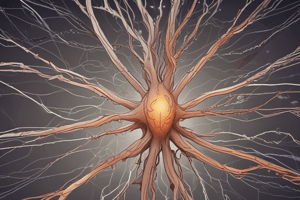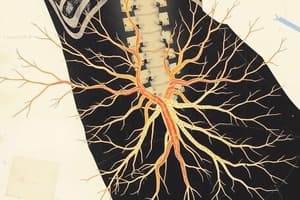Podcast
Questions and Answers
Which of the following nerves is NOT a branch of the lumbar plexus?
Which of the following nerves is NOT a branch of the lumbar plexus?
- Iliohypogastric nerve
- Femoral nerve
- Tibial nerve
- Superior gluteal nerve (correct)
Which nerve is formed by the dorsal division of L4-S2?
Which nerve is formed by the dorsal division of L4-S2?
- Tibial nerve
- Common fibular nerve (correct)
- Femoral nerve
- Sciatic nerve
Which of the following nerves is responsible for the posterior cutaneous sensation of the thigh?
Which of the following nerves is responsible for the posterior cutaneous sensation of the thigh?
- Iliohypogastric nerve
- Ilioinguinal nerve
- Lateral femoral cutaneous nerve
- Posterior cutaneous nerve of thigh (correct)
What is the main component of the lumbosacral trunk?
What is the main component of the lumbosacral trunk?
Which of the following nerves is NOT a branch of the sacral plexus?
Which of the following nerves is NOT a branch of the sacral plexus?
What is a common cause of lumbosacral plexopathy?
What is a common cause of lumbosacral plexopathy?
What is the primary functional loss associated with femoral nerve injury?
What is the primary functional loss associated with femoral nerve injury?
Which nerve is commonly compressed by a tight piriformis muscle?
Which nerve is commonly compressed by a tight piriformis muscle?
What is the primary symptom of tibial nerve injury?
What is the primary symptom of tibial nerve injury?
Which of the following is NOT a common site of nerve compression?
Which of the following is NOT a common site of nerve compression?
What is the primary functional loss associated with sciatic nerve injury?
What is the primary functional loss associated with sciatic nerve injury?
What is the primary symptom of obturator nerve injury?
What is the primary symptom of obturator nerve injury?
What is a common cause of peroneal neuropathy?
What is a common cause of peroneal neuropathy?
What is the primary functional loss associated with tibial nerve injury?
What is the primary functional loss associated with tibial nerve injury?
Which nerve is commonly affected in idiopathic lumbosacral plexitis?
Which nerve is commonly affected in idiopathic lumbosacral plexitis?
Flashcards are hidden until you start studying
Study Notes
Lumbosacral Plexus
- The lumbosacral plexus consists of the lumbar plexus (L1-L4) and sacral plexus (S1-S4)
- The lumbar plexus forms in the posterior part of the psoas major muscle from the ventral rami of L1-L4
Lumbar Plexus Branches
- Femoral nerve
- Obturator nerve
- Lateral femoral cutaneous nerve
- Iliohypogastric nerve
- Ilioinguinal nerve
- Genitofemoral nerve
Sacral Plexus
- Formed by the lumbosacral trunk (L4-L5) and ventral rami of S1-S3
Sacral Plexus Branches
- Sciatic nerve (L4-S3)
- Common fibular/peroneal nerve (dorsal division of L4-S2)
- Tibial nerve (ventral division of L4-S3)
- Superior gluteal nerve (dorsal L4-S1)
- Inferior gluteal nerve (dorsal L5-S2)
- Posterior cutaneous nerve of thigh (S1-S3)
Causes of Lumbosacral Plexopathy
- Iliacus hematoma (only femoral nerve)
- Psoas (retroperitoneal) hematoma
- Intrapartum maternal
- Pelvic mass
- Malignant neoplasms (lymphoma; ovarian, colorectal, and uterine cancer)
- Retroperitoneal lymphadenopathy
- Abscess
- Pelvic fracture
- Radiation injury
- Diabetes (diabetic amyotrophy, diabetic proximal neuropathy)
- Idiopathic lumbosacral plexitis
Peroneal Neuropathy at the Fibular Head
- Compression (weight loss, perioperative)
- Trauma
- Disc herniation
- Spinal stenosis
- Pelvic surgery
- Hematoma
- Prolonged labor
- Hip surgery
- Injection injury
- Coma
Clinical Features of Peripheral Nerve Lesions
- Ankle inversion: normal, weak, weak, normal or mildly weak
- Toe flexion: normal, weak, weak, normal or mildly weak
- Plantar flexion: normal, normal, normal, normal or mildly weak
- Ankle jerk: normal, normal (unless with S1), normal (unless with S1), normal or depressed
Patterns of Muscle Weakness and Functional Loss
- Femoral nerve: illiacus, sartorius, pectineus, quadriceps group
- Obturator nerve: obturator externus, adductor muscle group
- Sciatic nerve: hamstring group, adductor magnus
- Tibial nerve: plantar flexors, popliteus, tibialis posterior, flexor digitorum longus, flexor hallucis longus
Studying That Suits You
Use AI to generate personalized quizzes and flashcards to suit your learning preferences.




